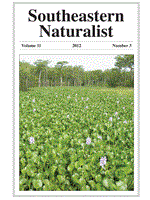Odocoileus virginianus (White-tailed Deer) have become overabundant in many urban and suburban areas, which can cause concern about exposure of humans and pets to zoonotic pathogens. Bald Head Island, NC is a small barrier island that has experienced ongoing residential development since the mid-1980s and has a relatively high deer density (15–17 deer/km2). To address concerns expressed by residents, we screened ≈13% of the White-tailed Deer population for potential zoonotic pathogens. We collected blood from 8 deer in January through March 2008 and 5 deer in January 2009. We tested sera for antibodies to Anaplasma phagocytophilum, Borrelia burgdorferi, and six serovars of Leptospira interrogans; and whole blood samples for Bartonella spp. and B. burgdorferi DNA. All sera were negative for antibodies to L. interrogans; two samples were seropositive for A. phagocytophilum, and one was seropositive for B. burgdorferi. Whole blood PCR results were negative for Bartonella spp. and B. burgdorferi. Continued surveillance for wildlife diseases on Bald Head Island is necessary to determine prevalence of specific pathogens, their impacts on the White-tailed Deer population, and the risk of exposure to humans and pets.
How to translate text using browser tools
1 September 2012
Survey of Zoonotic Pathogens in White-Tailed Deer on Bald Head Island, North Carolina
Brandon L. Sherrill,
Anthony G. Snider,
Suzanne Kennedy-Stoskopf,
Christopher S. DePerno
ACCESS THE FULL ARTICLE

Southeastern Naturalist
Vol. 11 • No. 3
September 2012
Vol. 11 • No. 3
September 2012




